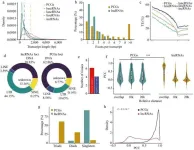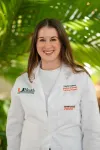(Press-News.org) (Santa Barbara, Calif.) — Sometimes simple solutions are better. It all depends on the nature of the problem. For humpback whales, the problem is the rope connecting a crab trap on the seafloor to the buoy on the surface. And for fishermen, it’s fishery closures caused by whale entanglements.
Managing this issue is currently a major item on California’s agenda, and it appears less fishing gear may be the optimal solution. So says a team of researchers led by Christopher Free, at UC Santa Barbara, after modeling the benefits and impacts that several management strategies would have on whales and fishermen. Their results, published in the journal Biological Conservation, find that simply reducing the amount of gear in the water is more effective than dynamic approaches involving real-time monitoring of whale populations. There may even be solutions on the horizon that provide these benefits with fewer drawbacks.
“We were trying to figure out what types of management strategies would work best at reducing whale entanglements in the Dungeness crab fishery while also minimizing impacts to fishing,” said first author Free, a researcher at the university’s Marine Science Institute. “And what we found is that some of the simpler strategies, such as just reducing the amount of gear allocated to the fishermen, outperformed a lot of the more complex management strategies.”
Management falls into two basic categories. Static strategies remain the same regardless of conditions. These include gear reductions, season delays and early closures. Meanwhile, dynamic strategies adapt based on incoming information. These come in proactive and reactive flavors, depending on whether the change is based on surveys determining where whales are abundant or observed entanglements indicating where risk might be high.
Free and his colleagues created a computer model to investigate different management actions based on crab abundance, fisherman behavior and whale behavior. The model predicts how a given approach will affect total catch as well as the frequency with which whales encounter traps. Strategies included gear reductions and closures triggered by surveys, entanglements or time of year. The authors judged each action based on how well it reduced entanglement risk, while minimizing disruptions to the fishing season and total landings.
“No strategy was a panacea,” Free said. “But when we weighed these different methods holistically, gear reductions really stuck out as being the most efficient way of protecting whales with the least impacts to fishing.” A 30% reduction emerged as the optimal course of action.
Free has several explanations for these findings. First and foremost, reducing the amount of gear directly addresses the problem: the number of lines in the water for whales to get entangled in. Dynamic closures merely move these lines around. Static strategies also don’t rely on surveys or monitoring efforts which can be inconsistent, irregular and expensive.
The logistics involved in dynamic approaches also hamper their effectiveness. Unlike many types of fishing gear, crab traps are unsupervised, often for days at a time. What’s more, dynamic actions have a two-week implementation period. “That two-week delay really undermines the effectiveness of this type of dynamic management,” Free said.
Given this caveat, a regional closure might end up moving traps into an area that’s actually more risky for whales. There can also be a long delay between when a whale gets entangled and when it’s spotted. The animal could have dragged the gear for several weeks and hundreds of miles, meaning nobody can be sure where and when the whale got ensnared.
In contrast, static strategies are cheap and predictable. They require no costly equipment, and don’t introduce any uncertainty into the fishing season or fishing grounds. The Dungeness crab fishery is a derby fishery, characterized by intense fishing effort early on. The abundance of crabs means that fishermen can still make good catches in those early weeks even with fewer traps. Indeed, most of the catch is landed early in the season.
According to Free, the fishery regularly catches 90% of male crabs in a season, yet simple management measures have maintained a sustainable and profitable fishery. Fishermen can only keep males above a certain size during a certain season. This ensures that young crabs can grow up, females can lay eggs, and the studs can fertilize the next generation. Turns out that the crab population is not limited for want of males.
But what was once the easiest fishery to manage is now among the hardest. Climate change has shifted whale foraging ground inshore — intensifying the overlap with fishing — and made toxic algae blooms more common — which can delay the opening of the season due to health risks. For instance, a severe algae bloom in 2015 delayed the opening until April, precisely when humpbacks are headed north to their summer feeding grounds. This caused a huge spike in entanglements, and the Center for Biological Diversity sued California for failing to comply with the Endangered Species Act and Marine Mammal Protection Act. The state settled, and there’s since been a rush to overhaul the fishery’s management plan.
To that end, the researchers developed a tool that enables policy-makers and regulators to test any management strategy they can think of, including ones the authors didn’t consider. Models such as this one are crucial for these sorts of questions, where it’s impractical, unethical or impossible to run an experiment.
One shortcoming of this model is that it aggregates all fishermen together, despite significant differences between them. For instance, some fishermen switch to different species after the initial boom, while others continue to focus on crabs. Vessel size, geography and license type all matter as well. It will take more research to understand how regulatory impacts distribute among different fishermen.
Free plans to investigate how to minimize the impact of toxic algae blooms on the fishery. Dynamic strategies actually show much more promise for tackling this issue. He’d like to design a more precise algae monitoring system so that closures are limited to just what is essential for protecting public health. Clearly, there’s still much to learn about what makes an issue more amenable to static or adaptive management strategies.
Some people are searching for an option that could avoid entanglements altogether. “Ropeless gear would be the silver bullet solution to this problem,” Free said. If there are no ropes, then whales can’t get tangled.
This technology does exist, but it presents challenges. A submerged buoy that can be released by an acoustic signal lets fishermen recover their traps without leaving lines to entangle whales in the water. But these high-tech traps are far more expensive than a simple crab pot on a line. Tthe highest cost would likely come from the additional time required to locate and recover such traps. A few extra minutes can compound over hundreds of traps. Surface buoys also signal to other fishermen that a spot is claimed, and enable officials to locate and check traps. Clearly the concept still has some bugs to work out.
There is another viable alternative though: stringing multiple traps along a single line. With this strategy, fishermen could deploy the same number of traps while reducing the number of lines in the water, which are the real threat to whales. “It would be better than gear reductions,” Free said. However, it is currently illegal in California to string multiple traps together. The technique is widespread in the Atlantic lobster fishery, so may work for crabs as well. Regulations could simply be changed to require a certain percentage of traps be trawled together.
“I really believe in this result,” Free said, “that gear reductions offer the most promise for saving whales while maintaining a profitable fishery.”
END
Reducing fishing gear could save whales with low impacts to California’s crab fishermen
Researchers at UC Santa Barbara found that the static strategy was more effective and less disruptive than dynamic management approaches
2023-09-30
ELSE PRESS RELEASES FROM THIS DATE:
Engineering researchers to study wireless communication and machine learning with NSF grant
2023-09-30
A virtual reality (VR) game crashes. A robot rolls dangerously close to the edge of a cliff. An autonomous vehicle speeds toward a pedestrian. Without intelligent control happening every millisecond, accidents can occur. This control can mean applying the brake of an autonomous vehicle to save a life or creating a more user-friendly augmented reality experience.
Two professors in the Department of Electrical and Computer Engineering at Texas A&M University are working to enhance and advance the future ...
Wheat's long non-coding RNAs unveiled: A leap in understanding grain development
2023-09-30
Wheat is a global staple food and plays a pivotal role in the livelihoods of billions of people. Although long non-coding RNAs (lncRNAs) have been recognized as crucial regulators of numerous biological processes, our knowledge of lncRNAs associated with wheat (Triticum aestivum) grain development remains minimal.
Seed Biology published an online paper entitled “A comprehensive atlas of long non-coding RNAs provides insight into grain development in wheat” on 04 September 2023.
To ...
New study will examine irritable bowel syndrome as long COVID symptom
2023-09-30
Researchers with the ongoing Arizona CoVHORT research study at the University of Arizona Mel and Enid Zuckerman College of Public Health were awarded $3.2 million by the National Institute of Diabetes and Digestive and Kidney Diseases for a five-year study of gastrointestinal symptoms, specifically irritable bowel syndrome, as a condition of long COVID.
Led by epidemiologist Kristen Pogreba-Brown, PhD, MPH, the CoVHORT study is a longitudinal research study of COVID-19 and post-COVID conditions. The ...
Department of Energy announces up to $500 million for basic research to advance the frontiers of science
2023-09-29
WASHINGTON, D.C. - The U.S. Department of Energy (DOE) today announced up to $500 million in funding for basic research in support of DOE’s clean energy, economic, and national security goals. The funding will advance the priorities of DOE’s Office of Science and its major programs, including Advanced Scientific Computing Research, Basic Energy Sciences, Biological and Environmental Research, Fusion Energy Sciences, High Energy Physics, Nuclear Physics, Isotope R&D and Production, and Accelerator R&D and Production. This funding opportunity will help achieve the Biden Administration’s ...
Neural activity associated with motor commands changes depending on context
2023-09-29
Standing at a crosswalk, the signal changes from “don’t walk,” to “walk.” You might step out into the street straight away, or you might look both ways before you cross.
In either scenario, you see the light change, you cross the street. But the context is different; in one case, you didn’t think twice. In the other, you waited; looked to the left and right; saw the coast was clear; then stepped into the street.
Researchers have known that certain brain activity when you see the light change and certain brain activity when you step out into the street are the same no matter the context -- there’s a known “pathway” ...
Argonne joins Illinois manufacturers for “Makers on the Move” tour
2023-09-29
Manufacturers throughout Illinois will have the chance to learn about working with the Materials Manufacturing Innovation Center (MMIC) at the U.S. Department of Energy’s (DOE) Argonne National Laboratory, when the MMIC gets on the bus for the second annual Makers on the Move tour.
The Illinois Manufacturing Association and Illinois Manufacturing Excellence Center (IMEC) sponsor the eight-day, 1,000-mile tour, designed to showcase high-tech, clean, diverse and sustainable modern manufacturing. The branded Makers on the Move bus will stand out on the state’s roadways as it visits facilities, colleges ...
High cure rate, low toxicity maintained with shortened radiation treatment for intermediate risk prostate cancer, study finds
2023-09-29
ARLINGTON, Va., September 29, 2023 — People with intermediate risk, localized prostate cancer can be treated as effectively using fewer and higher doses of radiation therapy delivered over five treatment sessions as they can with lower doses delivered over several weeks, a new phase III randomized trial suggests. The findings, which are the latest from a series of studies investigating the benefits of stereotactic body radiation therapy (SBRT) for people diagnosed with prostate cancer, will be presented Monday at the American Society for Radiation Oncology (ASTRO) Annual Meeting.
The PACE ...
True progression or pseudoprogression in glioblastoma patients?
2023-09-29
MIAMI, FLORIDA (STRICTLY EMBARGOED UNTIL SEPT. 29, 2023 AT 5PM ET) – Is it true progression or pseudoprogression in tumor growth?
That’s the critical question for radiation and medical oncologists treating patients with glioblastoma, the most common and aggressive form of brain cancer. Distinguishing between these types of progression is vitally important for treatment management.
“Knowing if it’s true progression, indicative of a poor response to treatment, or pseudoprogression, a favorable response that may look worse due to swelling or tumor necrosis, is essential for clinicians,” said Eric Mellon, MD, PhD, a radiation oncologist and researcher ...
ASTRO 2023 Session shines spotlight on physician burnout
2023-09-29
MIAMI, FLORIDA (EMBARGOED UNTIL SEPT. 29, 2023, AT 5 PM ET, 2023) – Physician burnout was already a trending topic within the medical community before 2020, when the COVID-19 pandemic brought national attention to the issue.
Typical stressors such as long hours, poor work-life balance, frustrating insurance denials and cumbersome medical documentation were compounded by new challenges from a novel, deadly virus that killed millions worldwide and necessitated a paradigm shift in care delivery.
The side effects were widespread and readily apparent. By late 2021, research by the American Medical Association, Mayo Clinic and Stanford ...
Embargoed Sylvester Comprehensive Cancer Center ASTRO 2023 Tip Sheet
2023-09-29
ALL INFORMATION EMBARGOED UNTIL 5 P.M. ET ON SEPT. 29, 2023
Panel Discussion
Getting it All Done – Strategies for Coping With Professional Burnout
Crystal Seldon Taswell, MD, Sylvester radiation oncologist and researcher, will co-moderate a panel discussion on physician burnout within radiation oncology and medicine. The discussion, titled “Getting It All Done -- Practical Strategies at All Career Stages,” will include background on the extent of the problem, as well as the curriculum gap for residents regarding time management, balancing ...
LAST 30 PRESS RELEASES:
Autistic and non-autistic faces may “speak a different language” when expressing emotion
No clear evidence that cannabis-based medicines relieve chronic nerve pain
Pioneering second-order nonlinear vibrational nanoscopy for interfacial molecular systems beyond the diffraction limit
Bottleneck in hydrogen distribution jeopardises billions in clean energy
Lung cancer death rates among women in Europe are finally levelling off
Scientists trace microplastics in fertilizer from fields to the beach
The Lancet Obstetrics, Gynecology, & Women’s Health: Taking paracetamol during pregnancy does not increase risk of autism, ADHD or intellectual disabilities, confirms new gold-standard evidence review
Taking paracetamol during pregnancy does not increase risk of autism, ADHD or intellectual disabilities
Harm reduction vending machines in New York State expand access to overdose treatment and drug test strips, UB studies confirm
University of Phoenix releases white paper on Credit for Prior Learning as a catalyst for internal mobility and retention
Canada losing track of salmon health as climate and industrial threats mount
Molecular sieve-confined Pt-FeOx catalysts achieve highly efficient reversible hydrogen cycle of methylcyclohexane-toluene
Investment in farm productivity tools key to reducing greenhouse gas
New review highlights electrochemical pathways to recover uranium from wastewater and seawater
Hidden pollutants in shale gas development raise environmental concerns, new review finds
Discarded cigarette butts transformed into high performance energy storage materials
Researchers highlight role of alternative RNA splicing in schizophrenia
NTU Singapore scientists find new way to disarm antibiotic-resistant bacteria and restore healing in chronic wounds
Research suggests nationwide racial bias in media reporting on gun violence
Revealing the cell’s nanocourier at work
Health impacts of nursing home staffing
Public views about opioid overdose and people with opioid use disorder
Age-related changes in sperm DNA may play a role in autism risk
Ambitious model fails to explain near-death experiences, experts say
Multifaceted effects of inward foreign direct investment on new venture creation
Exploring mutations that spontaneously switch on a key brain cell receptor
Two-step genome editing enables the creation of full-length humanized mouse models
Pusan National University researchers develop light-activated tissue adhesive patch for rapid, watertight neurosurgical sealing
Study finds so-called super agers tend to have at least two key genetic advantages
Brain stimulation device cleared for ADHD in the US is overall safe but ineffective
[Press-News.org] Reducing fishing gear could save whales with low impacts to California’s crab fishermenResearchers at UC Santa Barbara found that the static strategy was more effective and less disruptive than dynamic management approaches




